'Blood sucking' parasites
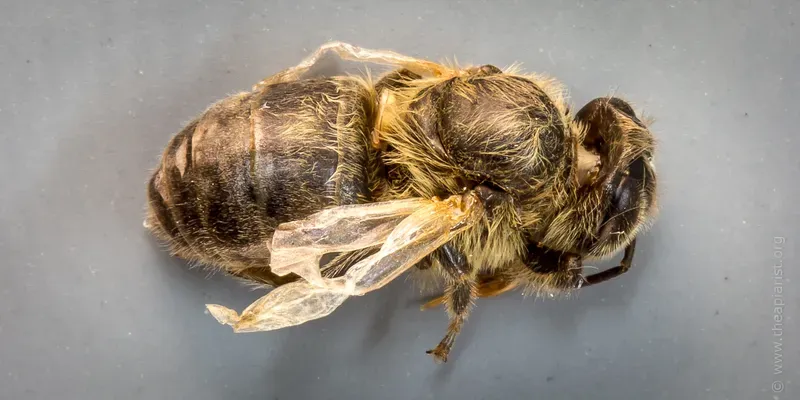
My internet connection still resembles a tangled ball of frayed, wet, wool. Very frayed. The connection is slow, intermittent and a thoroughly frustrating experience. This post is therefore brought to you thanks to Border Meringues, undoubtedly the best coffee shop at the Riverside Workshops in Jedburgh {{1}}. The combination of their WiFi password, a procession of flat white coffees and the occasional slice of excellent almond, apple and raspberry cake helped turn my rambling analogue jottings into digital reality.
The choice of almond, apple and raspberry cake was determined by the time of day ... at lunchtime I'd have opted for a toasted sandwich or burger. I'd need something more substantial to get me through to my afternoon slice of chocolate roulade or shortbread.
Diet therefore varies according to needs {{2}}, or what is available on the menu.
But enough about my diet, what does Varroa eat?
It turns out that, like this bloated blogger, the diet of the mite also varies according to what's available to the ectoparasite (and possibly to its needs as well). It's an interesting story and one that has recently been updated in a paper published last January (Han et al., 2024).
However, before diving into the main course, we need to tackle the starters and briefly discuss what previous studies have concluded about the diet of Varroa.
But, before that there's an aperitif ... the life cycle of Varroa.
The life cycle of Varroa
Varroa is an ectoparasite. It feeds on developing honey bee pupae within capped cells, and on adult workers during the misnamed phoretic stage of the life cycle.
'Misnamed' because phoretic is derived from the Ancient Greek word meaning 'being carried'. More specifically, the word means:
An association between two organisms in which one is carried on the body of the other, without being a parasite
If mites were truly phoretic, they would be carried on adult bees, but they would not feed on adult bees.
But they do.
The life cycle of Varroa therefore has two alternating phases; a reproductive phase, which occurs within a capped cell, and a dispersal phase when the mites are outside the cell, crowd surfing on nurse bees within the colony.
The reproductive phase
The reproductive phase is initiated when a mated foundress female mite enters a cell containing a late-stage larva, shortly before the cell is capped. Over the next few days the mite lays a series of eggs (one every 30 hours or so), the first of which gives rise to a male mite, the remainder hatching to produce female mites.
The foundress feeds on the developing pupa by perforating the cuticle to create a feeding site which is subsequently shared with her growing family.
The male mite mates with his sisters {{3}} to produce new, mated females which are released when the cell is uncapped - either when the developed worker emerges or, if the pupa dies before emergence, when the cell is opened and cleaned by nurse bees in the hive.
Further sordid details and timings of the life cycle of Varroa can be found in an earlier post or in a review article (now a bit dated) by Peter Rosenkranz (Rosenkranz et al., 2010).
The dispersal phase
The dispersal phase is important for both the mite and the beekeeper.
By hitching a lift - predominantly but not exclusively - on nurse bees the mite is kept in the vicinity of developing brood, so can readily 'jump ship' into a cell once the time is right, or the opportunity presents itself.
It is during the dispersal phase that mites are susceptible to the the majority of approved miticides.
With the exception of formic acid (the active ingredient in MAQS and FormicPro), which penetrates cell cappings, the remaining approved miticides are only active against the misnamed phoretic mites.
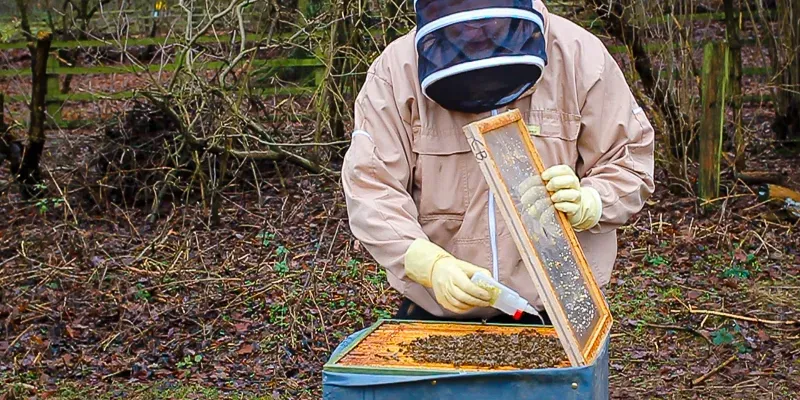
That is one of the reasons why treatment of broodless colonies, e.g. by trickling oxalic acid in midwinter, or by combining miticide treatment with a shook swarm, is so much more effective and/or so much faster, than treating colonies containing sealed brood.
The dispersal phase is also important because it allows mites to be transported from one colony to another, for example on drifting bees or after hitching a lift back on a worker robbing a colony weakened by Varroa and viruses.
Finally, the dispersal phase also includes any broodless period in the colony, either during requeening or overwinter when brood rearing is stopped. Although the mites may not be 'dispersing' during this time, they may need to survive for long periods, and so require sustenance ... therefore explaining why these phoretic mites are actually parasitising i.e. feeding on, the adult bees that carry them.
The historical diet of Varroa
Historically, by which I mean anything before 2019, the consensus was that Varroa fed on haemolymph, or 'bee blood' as it is often described in less technical treatises. A series of studies dating back to the 1970's had determined this, primarily using radioisotope analysis.
Don't stop reading ... I'm going to try and keep the technical details to a minimum {{4}}. A radioisotope is simply a detectable 'label' that can be used to identify things.
For example, strontium-90 (90Sr) is a radioactive isotope of strontium that can replace calcium in tissues, such as haemolymph. If a bee containing 90Sr-labelled haemolymph is fed upon by a mite, and the mite is subsequently analysed and shown to contain 90Sr (which would not normally be present), then you would conclude that the mite ingested haemolymph from the bee.
Although most scientists - and certainly all beekeepers - considered that Varroa feeds on haemolymph, these type of radioisotope studies are not without problems. Importantly, the certainty of the conclusions drawn from these type of labelling studies is entirely dependent upon the specificity of the label.
Unfortunately, 90Sr isn't very specific. For example, it can get into tissues other than haemolymph.
Varroa destructor feeds primarily on honey bee fat body tissue and not hemolymph
This was the title of a landmark study published by Samuel Ramsey in 2019 (Ramsey et al., 2019) {{5}}.
I discussed this paper at length when it was published, so won't rehash the experimental data here.

Despite the definitive title, I was a little sceptical. The study involved three experiments, only one of which definitively addressed the diet of Varroa. The other two only really provided circumstantial support.
The experimental questions addressed were:
- When Varroa feeds, what host tissues are ingested?
- Where on the bee do mites feed? Is it primarily or exclusively near the fat body?
- What sort of diet is required to maintain Varroa and allow their reproduction in vitro.
The first question was addressed using labelling experiments, though these labels were fluorescent rather than radioactive. The fluorescent labels used (Nile Red {{6}} or Uranine) were much more specific than radioisotopes. Ramsey showed that fluorescent fat body tissue was ingested by mites feeding on adult bees. This was a very nice experiment.
The other two questions provided additional circumstantial support ... mites fed at or near the location of the fat body and mites in vitro (effectively in a test tube, supported on an artificial diet) did better when fed fat body tissue ... though, in fairness, better still wasn't very good {{7}}.
The Ramsey study largely used adult bees, and the conclusions were then extrapolated to all stages of the life cycle of the mite, resulting in the definitive "not hemolymph" in the title of the paper {{8}}.
Extrapolation and being definitive (particularly in a title) are a dangerous combination ...
What and where is the fat body?
The fat body is (broadly) analogous to the human liver.
In bees ...
... it acts as a major organ for nutrient storage, energy metabolism and detoxification of things like pesticides.
In the adult bee it is located in a sheet underneath the abdominal cuticle, explaining why the feeding locations identified by Ramsey et al., (2019) were used to provide supportive evidence of the diet of Varroa {{9}}.
However, developing pupae undergo metamorphosis, during which everything in the bee is mixed up and rearranged ... or as Han et al., (2024) more scientifically states:
... the fat body of the metamorphosing pupae is diffuse in the hemolymph-filled body cavity during the remodeling and formation of adult tissues.
The Han study set out to specifically determine whether foundress mites and their progeny feed on fat body or haemolymph tissue. Consequently, two of the experiments were very similar to those conducted by Ramsey et al., (2019).
Where is the feeding site on pupae?
Han et al., (2024) photographed 1285 pupae parasitised by Varroa and identified the location of the feeding site (visually, after staining with a dye). 90% of all feeding sites were on the abdomen, and 85% were located on the sternite (the ventral shield) of the second abdominal segment.
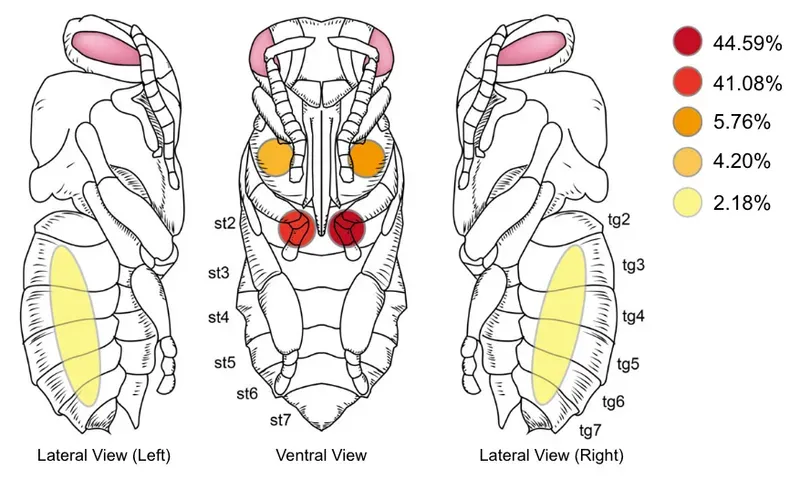
There was nothing particularly surprising about this observation, which was in agreement with numerous earlier studies. They speculate (as had others) that this site was favoured as the cuticle here is thinner, and is directly over a large haemolymph-containing cavity.
Supportive certainly, but not definitive {{10}}
What do Varroa feeding on pupae ingest?
Again, as in the Ramsey study, this experiment used Nile Red and Uranine, the same specific fluorescent dyes that colour the fat body red and haemolymph green, respectively. In control studies they demonstrated that the dyes had no impact on the feeding or reproduction of mites.
Varroa that had fed on dye-stained pupae were predominantly green ... they were feeding on haemolymph tissue, not on fat body tissue. Even with my colourblindness, the images look compelling (you need to look at Figure 3 in the original paper which has too many panels to reproduce here).
The Varroa proteome
Oh no! Another new word ... what is a proteome?
You've probably heard of the term microbiome, which means the entire population of microorganisms in a particular environment.
For example, the microbiome of the soil impacts everything from geochemical cycling, to climate change and plant, animal and human health.
No?
Well, don't worry, those three linked papers will help you get to sleep get you up to speed in, er, months.
Regular readers have heard of the microbiome of honey bees.
In a post titled 'You are what you eat' I described studies that showed how the microbiome of the honey bee gut influenced cuticular hydrocarbon profiles, the 'smell' that enables bees to recognise nestmates and discriminate them from robbers. It's a neat story.

So, just as the microbiome is a catalogue of bacteria {{11}} - both the species and abundance - in a particular environment, the proteome is a catalogue of the abundance and identity of proteins in a particular location.
The proteome is measured by fragmenting all the proteins present into short pieces and then identifying and quantifying the billions of fragments generated using mass spectometry. It's a clever, expensive and exquisitely sensitive method. The cost precludes its use by many (often poorly-funded) honey bee research laboratories, and the sensitivity means that contamination of one form or another can be an issue. Controls and comparisons are essential.
Stage-specific diets
To cut a long story short, Han and colleagues compared the honey bee proteins within the proteome of Varroa in both reproductive and dispersal phases of the life cycle. They compared these with the known proteome of honey bee haemolymph, and also investigated the presence and abundance of vitellogenin (a fat body protein).
Unfortunately, the proteome of the honey bee fat body has not been determined, so the presence of vitellogenin was used as a surrogate marker for all the proteins specific for the fat body.
Although ~58% of honey bee proteins were found in both reproductive- and dispersal-phase mites, 42% were unique to one or the other.
Analysis of the latter clearly showed that foundress (reproductive) mites and phoretic (dispersing) mites have a different diet, with the foundresses feeding on haemolymph and the phoretic mites feeding on the fat body.
So what does Varroa eat?
Ramsey was partly right ... Varroa does feed on the fat body of honey bees, but only during the dispersal phase of the life cycle where phoretic mites are being carried and are parasitising adult bees.
However, Ramsey was wrong in definitively stating "and not hemolymph" in the title of his paper. Foundress mites i.e. those in capped cells, do feed on haemolymph. To have been correct with this statement he'd have also had to limit the claim to adult mites on adult bees in the title, discussion and conclusions of the paper.
And there's more ...
I've skipped about 60% of the Han study to try and make the story understandable and less than 28,570 words long. There are all sorts of additional things in this data-rich paper, including a comparative diet analysis of Varroa and Tropilaelaps.
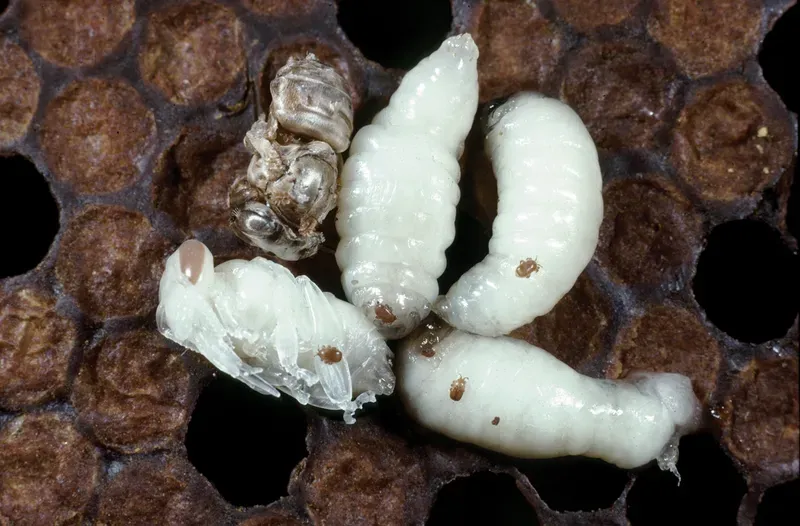
UK and US readers unfamiliar with Tropilaelaps - another parasitic mite of honey bees - should perhaps do a bit more reading as it is becoming more widely distributed, and has recently been identified in Europe for the first time (Brandorf et al., 2024).
Coming to an apiary near you ... 😞.
Why do reproductive and dispersal phases have (or need) different diets?
My choice of almond cake, burger, or shortbread is largely due to my preference for things that taste great, but that are not very good for me

'You are what you eat' and it's not pretty.
However, it's also determined by what Border Meringues have available.
If they've - understandably - sold out of shortbread I'd have to choose between a scone and the chocolate roulade {{12}}.
It's likely that the different diets consumed by Varroa during the reproductive and dispersal stages in the life cycle also reflect the availability of, and access to, haemolymph or fat body tissue.
During the reproductive phase the pupa is poorly defended and filled with abundant quantities of haemolymph, whereas the availability of haemolymph in adult bees is limited. In contrast, in adult bees the fat body tissues are localised and readily accessible from one of the few sites that are relatively resistant to the self- and allo-grooming activities of bees.
There may be additional reasons why reproducing Varroa slurp haemolymph and dispersing mites munch on fat body tissues.
Perhaps the haemolymph contains components that enhance mite reproductive success, and a diet of fat body tissue enhances mite longevity?
Ramsey attempted to show this using in vitro mite feeding and reproduction experiments, using a diet enhanced with fat body components. However, the results were a little underwhelming, perhaps because the experimental system is difficult and temperamental.
Further studies will be needed to determine whether the diet of mites is solely due to access/availability, or if it also reflects the metabolic needs of Varroa during particular stages of the life cycle.
My guess ... mite reproduction will be enhanced by components present in haemolymph and some other aspect of the mite life cycle will be boosted by a diet of fat body tissue.
From an evolutionary standpoint, this would make sense.
How will this new (old) insight help my beekeeping?
It probably won't.
These sort of precise (and pedantic) details of the life cycle of Varroa are pretty-much irrelevant for day-to-day beekeeping and mite management. As far as most beekeepers are concerned, it would make little difference whether mites eat haemolymph or chocolate roulade.
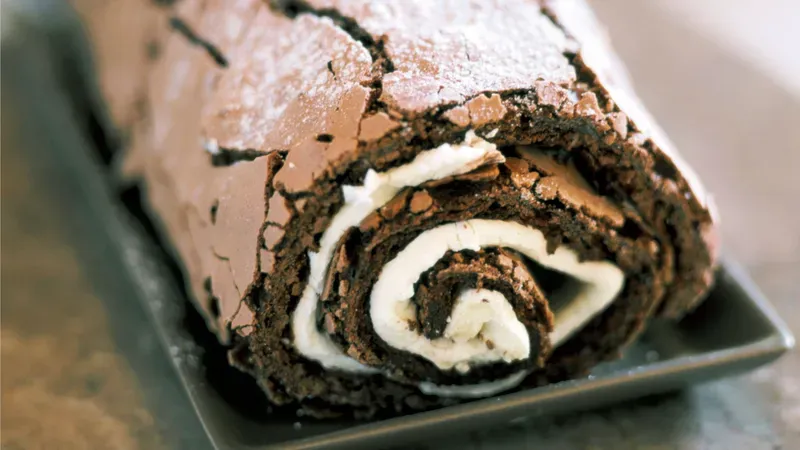
However, there are numerous attempts to develop targeted miticides that, delivered to the mite, kill it without impacting the host honey bee. Many of these are nucleic acid-based technologies, ingested by the bee (for example, in syrup) and subsequently transferred to the mite when the latter feeds. For these to be effective, the targeted miticide must be present in whatever the mite is eating.
Results to date have been promising, but not fantastic, and nothing like good enough to justify licensing.
Perhaps insufficient miticide is present in whatever the mite is eating?
A lipophilic ('fat loving') miticide would be present within the fat body and so would be ingested by 'phoretic' mites during the dispersal phase of the life cycle. However, it would be ineffective against reproducing mites. To target these the miticide would need to be present in the haemolymph.
I'm sure that the studies published by Han et al., and Ramsey and colleagues will, incrementally, lead to the attempted development of improved miticides for Varroa management.
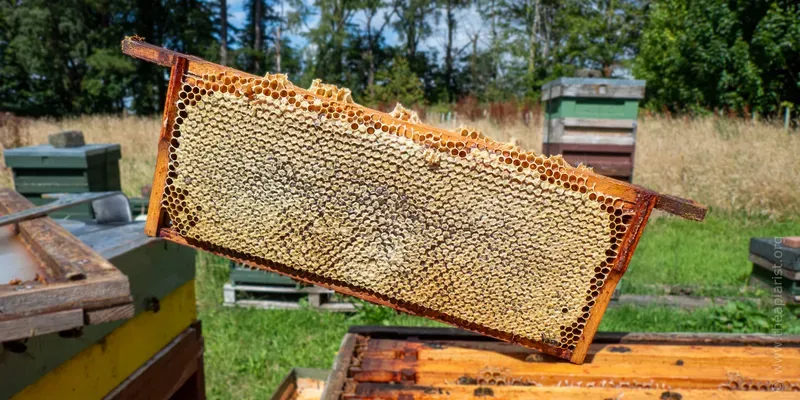
In the meantime, at least where I am, it's time for the honey harvest and extraction. Before very long I'll be preparing colonies for winter by feeding and applying miticides.
But, before that, there's the tricky decision about whether to have another piece of shortbread.
"Never eat more than you can lift" - Miss Piggy
Sponsor The Apiarist
The Apiarist covers 'the science, art and practice of sustainable beekeeping ... so much more than honey' and only exists because of the many hours spent in Border Meringues, quietly slurping flat white coffees and munching on almond cake.
If this, or other, posts has helped or inspired your beekeeping, or was amusing or enlightening, then please consider sponsoring The Apiarist.
Sponsorship costs less than £1/week annually, or little more than a large cappucino monthly. Sponsors receive the weekly posts, an irregular monthly newsletter, and an increasing number of sponsor-only content ... those starred ⭐ in the lists of posts.
Alternatively, help reduce my caffeine overdraft ... and please spread the word to encourage other beekeepers to subscribe.
Thank you.
References
Brandorf, A., Ivoilova, M.M., Yañez, O., Neumann, P., and Soroker, V. (2024) First report of established mite populations, Tropilaelaps mercedesae, in Europe. Journal of Apicultural Research 0: 1–3 https://doi.org/10.1080/00218839.2024.2343976.
Han, B., Wu, J., Wei, Q., Liu, F., Cui, L., Rueppell, O., and Xu, S. (2024) Life-history stage determines the diet of ectoparasitic mites on their honey bee hosts. Nat Commun 15: 725 https://www.nature.com/articles/s41467-024-44915-x.
Ramsey, S.D., Ochoa, R., Bauchan, G., Gulbronson, C., Mowery, J.D., Cohen, A., et al. (2019) Varroa destructor feeds primarily on honey bee fat body tissue and not hemolymph. Proceedings of the National Academy of Sciences 116: 1792–1801 https://www.pnas.org/doi/full/10.1073/pnas.1818371116.
Rosenkranz, P., Aumeier, P., and Ziegelmann, B. (2010) Biology and control of Varroa destructor. Journal of Invertebrate Pathology 103: S96–S119 https://www.sciencedirect.com/science/article/pii/S0022201109001906.
{{1}}: I've not been in the area long enough to get much further afield, but I'm certain that this description is completely accurate. As far as I can tell, it's the only coffee shop at the Riverside Workshops.
{{2}}: Though, to be honest, what my diet really needs is a light salad.
{{3}}: Ewwww!
{{4}}: Though I'm not going to stoop to the use of the term bee blood instead of hameolymph.
{{5}}: I should emphasise that, when quoting verbatim from published work I try and use the spelling they used, but use the British English spelling for my own words ... hence hemolymph vs. haemolymph.
{{6}}: Nile Red is lipophilic which means 'likes lipids', and specifically stains the fat body.
{{7}}: Because of the scientific collaborators I worked with then I was particularly sceptical of the in vitro studies which seemed far from conclusive to me.
{{8}}: Though, somewhere buried in the discussion, the authors did acknowledge that the diet of Varroa feeding on pupae needed to be confirmed.
{{9}}: This is analogous to assuming that a customer in a burger bar eats burgers - a reasonable assumption, but not necessarily correct. They might be there to buy a chicken and salad wrap, or ask for directions to the nearest petrol station.
{{10}}: Remember the burger bar.
{{11}}: Or, more correctly, microorganisms as the term encompasses more than just bacteria.
{{12}}: And I think we all know how that decision will go.

Join the discussion ...